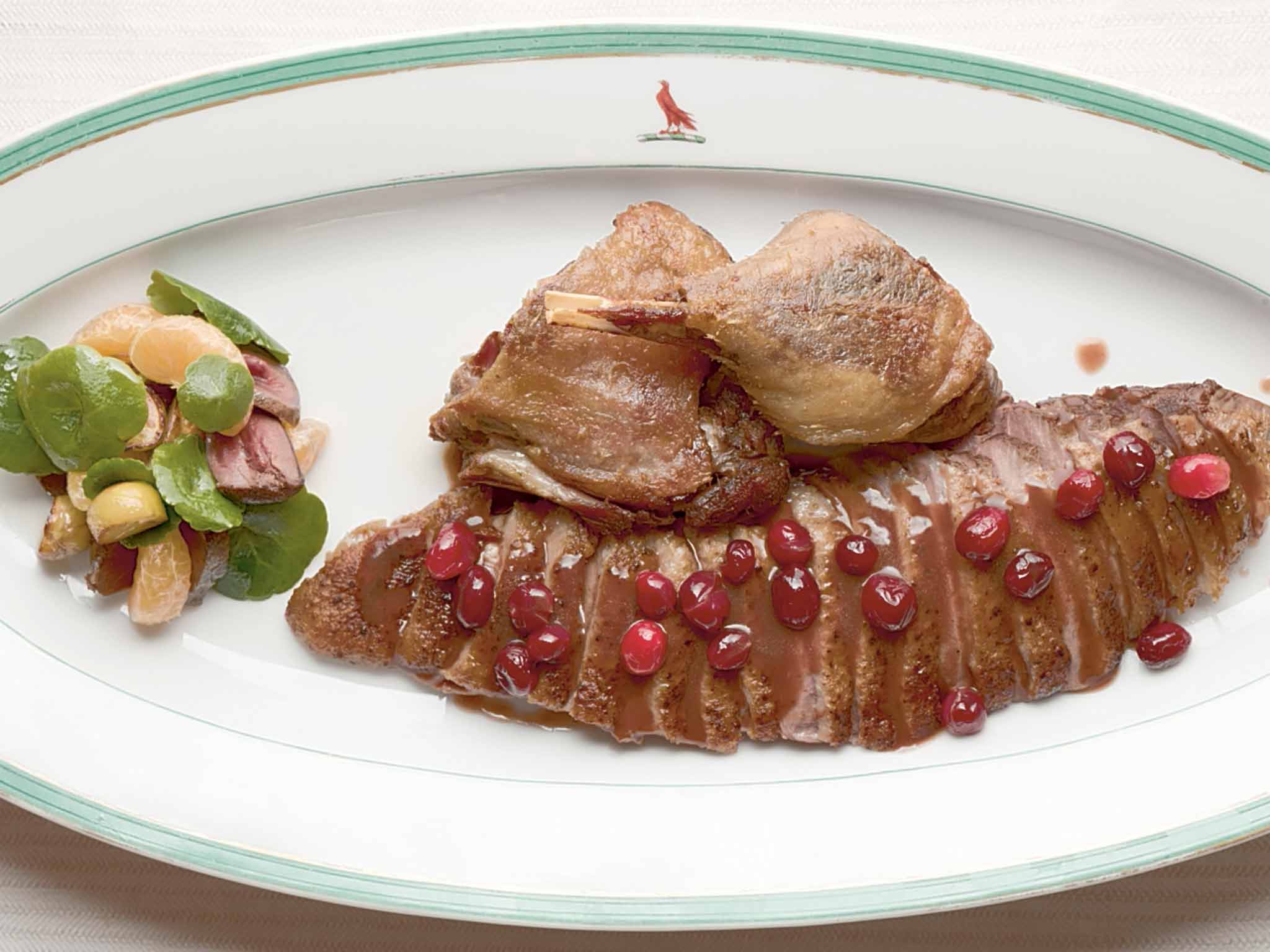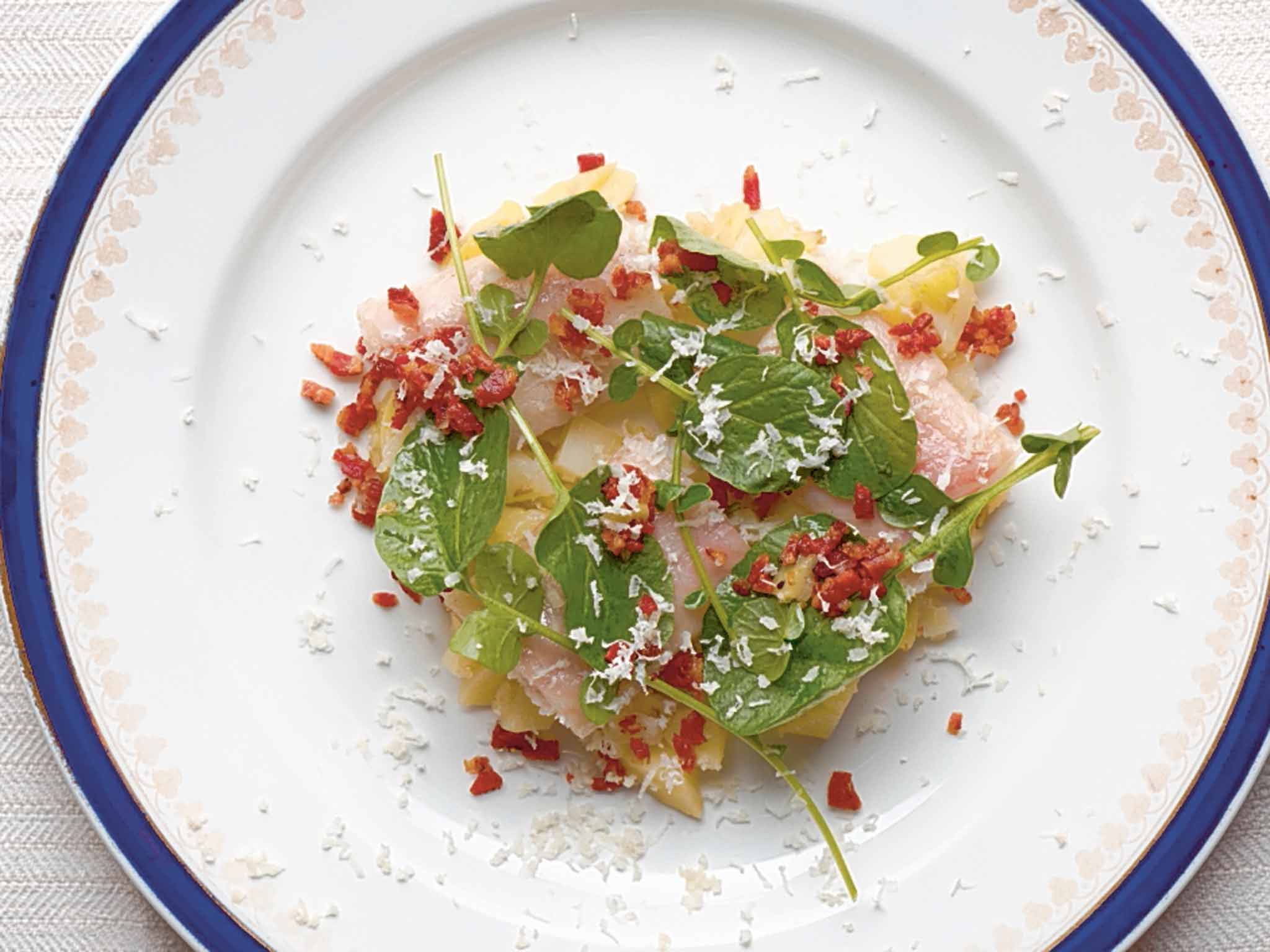Mark Hix recipes: Christmas lunch doesn’t have to be all dry turkey and heavy pudding
While most of us like traditional fare at Christmas, that doesn't mean you can't ring the changes by tweaking and improving cooking methods, or finding new ways of serving the regular ingredients.

Although turkey is what's expected by many guests, in truth it can often be a bit dry, so I've gone for goose here, which shouldn't cause too much consternation with traditionalists, and is rich and full of flavour. I've also offered a lighter dessert option than the usual rich pudding.
Smoked eel with horseradish potatoes and crispy bacon
Serves 6
Eel stocks are much healthier than they were a few years back and I'm quite happy to serve it on special occasions. Eel is one of my favourite smoked fish and it has a lot of flexibility as to how it's served – it's even great in a sandwich. I prefer to buy and serve my smoked eel on the bone. You can buy it from severnandwye.co.uk
8-10 new potatoes, cooked in their skins and then peeled
A piece of fresh horseradish 40-60g, peeled and grated
1tbsp crème fraîche
2-3 spring onions, finely chopped
1tbsp good quality mayonnaise
Salt and freshly ground black pepper
200-250g smoked eel fillet
A handful of land cress or similar leaves like rocket
8-10 slices of rindless streaky bacon, crisply grilled then finely chopped
Cut the potatoes into rough chunks then mix with the horseradish, crème fraîche, spring onions and mayonnaise, and season to taste.
To serve, spoon the potatoes on to serving plates, cut the eel into 3-4cm pieces and arrange on the potatoes with the leaves, then scatter the bacon over.

Roast goose with clementine and chestnut salad
Serves 6
Goose doesn't need to be fatty, and with careful preparation you can end up with a nice, meaty, lean and moist bird. You can reuse the cooking fat from the legs for delicious roast potatoes, and the rest of the carcass, once you've removed the breasts for this recipe, is great for gravy.
Offering a salad on Christmas Day lightens up the whole feast, which can be very welcome.
1 goose weighing 3-4kg, preferably with livers and gizzards
For the herb bag
A 25cm square piece of muslin; string
A few sprigs of thyme
A small piece of cinnamon stick
6 juniper berries, chopped
½tbsp coriander seeds
½tbsp white peppercorns
4 cloves
1 bay leaf
6 cloves of garlic, roughly chopped 400g duck or goose fat
2tsp sea salt
For the salad
A couple handfuls of small salad leaves
4 clementines or satsumas, segmented
12-4 chestnuts, fresh, frozen or vacuum packed, peeled and lightly toasted
2tbsp orange juice
1tbsp sherry vinegar
4tbsp walnut oil
Salt and freshly ground black pepper
Preheat the oven to 160C/gas mark 3. First prepare your goose by removing the legs: loosen them by pulling away from the side as you cut the skin with a sharp knife, then pull them all the way out and cut through the joint. Cut the legs in half at the joint then in half again, and pack them snugly into an appropriate sized, oven-proof, thick-bottomed pan or casserole dish with a lid.
Put all the herbs and spices into the muslin and tie securely with the string, then put it in with the legs. Melt the fat and pour over to cover the legs. Add the salt then slowly bring the fat to a simmer, drop in the gizzards if you have them, then cover the pan and cook in the oven for 1.5-2 hours or until the meat is soft but not falling off the bone. If cooking in advance you can store the pieces of leg in the fat in the fridge once cool.
On the day, preheat the oven to 220º/Gas mark 7. With the heel of a knife cut away the backbone so you are left with just the two breasts attached to the bones. Remove the legs from the fat and place in a roasting tray with a tablespoon or so of the fat, and cook in the oven for about 40-50 minutes, basting as they are cooking until they are crisp. Remove from the oven and keep warm but do not cover or they will go soggy.
Turn the oven down to 160C/Gas mark 3. Season the breasts, heat a large frying pan and cook them on a medium heat for 4-5 minutes to render the excess fat and until they are golden brown. Transfer to a roasting tray and place in the oven for an hour, keeping them pink, then leave to rest.
Carefully remove the breasts from the goose with a sharp knife then cut them into ½cm slices on a slight angle, and arrange on a warmed serving platter with the legs. You can serve this, as I've done here, with your favourite gravy recipe in which, to cut through the goose's richness, you've simmered a handful of cranberries for a few minutes.
Toss all of the ingredients together for the salad, season to taste and arrange in a serving bowl or on the platter.
Christmas baked apple
Serves 6
This makes a great alternative to Christmas pudding, while still keeping all the lovely seasonal flavours.
If you wish to save time you could use mincemeat – or even Christmas pudding moistened with a bit of rum, brandy or sherry – instead of making the filling.
For the pastry
250g plain flour
Pinch salt
½tbsp caster sugar
100ml water
60g lard
25g unsalted butter
1 small egg, beaten
For the filling
15 walnuts, chopped
15 whole, blanched almonds, chopped
2tbsp ground almonds
8 dates, chopped
2tbsp raisins, soaked in hot water for a couple hours and drained
3tbsp brown sugar
2-3 tbs cider brandy
2tbsp dark rum
2tbs medium sherry
A good pinch of mixed spice
6 medium-sized dessert apples, such as Cox's, Pink Lady or Braeburn
Preheat the oven to 200C/gas mark 6. First make the pastry: mix the flour, salt and sugar in a bowl and make a well in the centre. Heat the water, lard and butter in a saucepan to boiling point, then pour on to the flour and stir in with a wooden spoon to form a smooth dough.
Leave the dough covered for about 15 minutes or so until it can be handled. Divide into 4 balls and roll each of them on a lightly floured table. Cut into circles of about 14-16cm diameter.
Cut the top (the stalk end) off the apples and remove the cores with an apple corer or small sharp knife, making a hole about 2cm wide – enough to hold a good amount filling.
Mix all the ingredients for the filling together and stuff tightly into the apples. If there is any left over, spoon it on top.
Put an apple in the centre of each piece of pastry and bring the pastry up the sides of the apple, gathering it up and pinching it together, but leaving the top of the apple and filling exposed. Brush the pastry with some egg. Put a little foil on top of the filling then place them on a baking tray and bake for 45 minutes, or until the pastry is golden.
Delicious served with plenty of thick custard or double cream.
Join our commenting forum
Join thought-provoking conversations, follow other Independent readers and see their replies
Comments
Bookmark popover
Removed from bookmarks